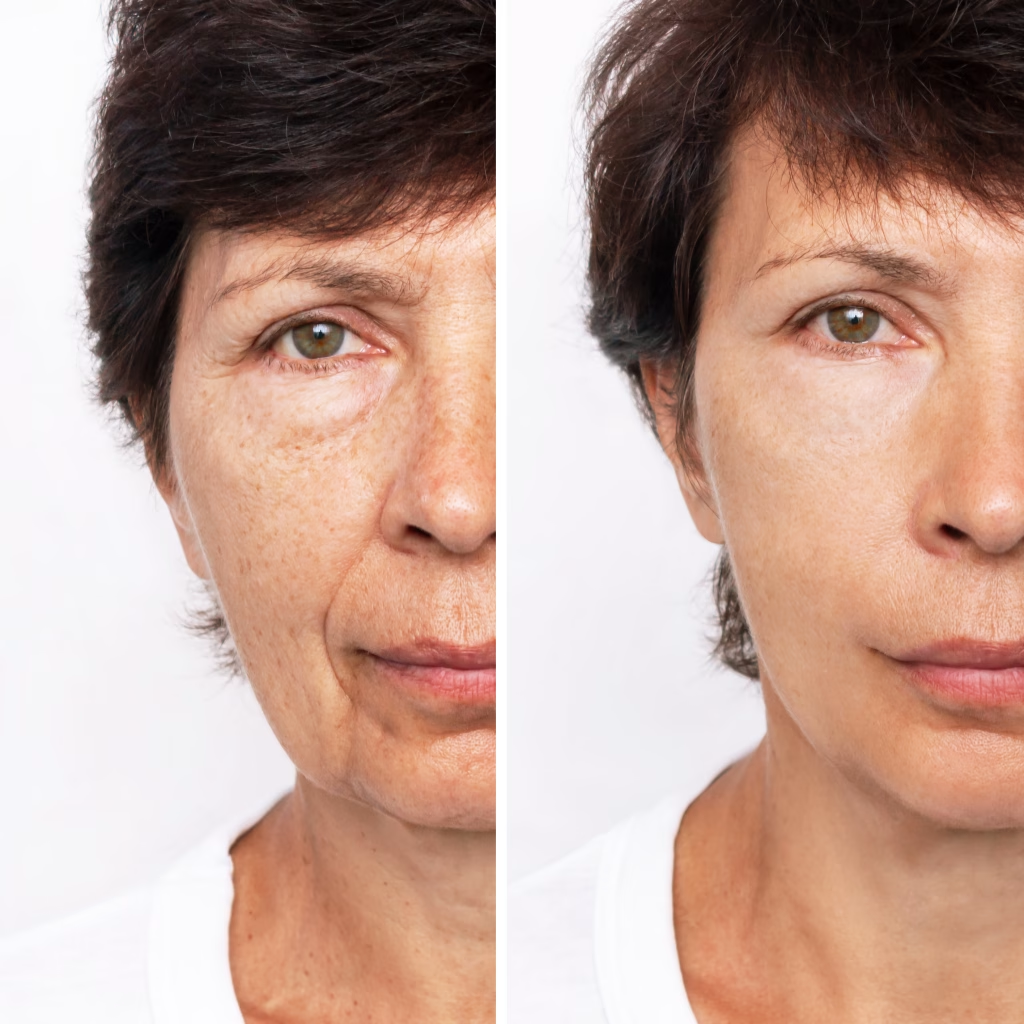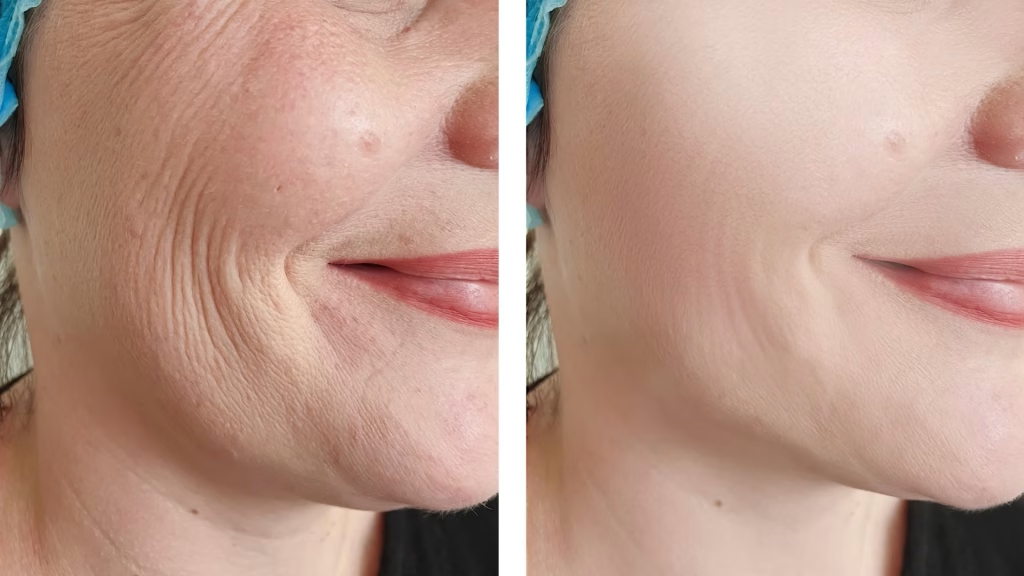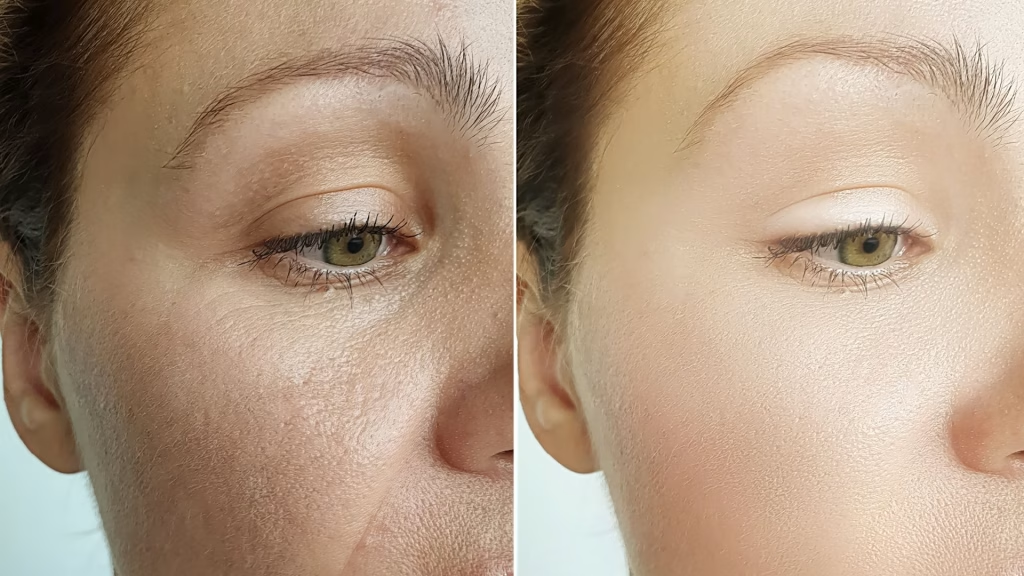Contents
- What is endoscopic midface lift?
- How is endoscopic midface lift surgery done?
- What to do after endoscopic midface lift surgery?
- What are the different midface lift techniques?
- The advantages of endoscopic midface lift surgery
- Who is a good candidate for endoscopic midface lift?
- How long does it take to see results from midface lift?
- How long does endoscopic midface lift last?
- What is temporal endoscopic midface lift?
- Endoscopic midface lift cost in Turkey
- Endoscopic midface lift recovery time
- Mİdfacelift before and after
- FAQs
What is endoscopic midface lift?
Objective | To rejuvenate the central area of the face by lifting sagging cheeks, smoothing nasolabial folds, and restoring youthful contours. |
Technique | Endoscopic midface lift techniques involve small incisions hidden within the hairline or inside the mouth, using an endoscope (a tiny camera) for precise visualization. |
Anesthesia | The anesthesia used for an endoscopic midface lift is typically general anesthesia or sometimes deep intravenous sedation. |
Candidate | Someone in their 30s to 50s experiencing early signs of ageing, such as sagging cheeks, deep nasolabial folds, or under-eye hollows. |
Recovery Process | Post-surgery, patients can expect mild swelling and bruising, with most returning to normal activities in 7 to 10 days. |
Aftercare | It includes proper wound care, avoiding strenuous activity, managing swelling with cold compresses, and following the surgeon’s post-op instructions. |
| Risks | Swelling, bruising, infection, numbness, scarring, and asymmetry. |
Cost | In the US or UK, its cost is from $6,000 to $12,000. In Turkey, it’s usually around $2,500 to $4,500. |
Endoscopic midface lift is a modern way to lift your cheeks and the area under your eyes without big scars.
Tiny cuts are made in hidden spots like your hairline or inside the mouth. Then, with a small camera (an endoscope), the surgeon gently lifts the tissues and repositions them.
This procedure works great if you’ve got sagging in the mid-face but your jawline still looks okay. Fast recovery and minimal scarring!
If you’re in your 30s to 50s and just want that fresh, rested look (not a dramatic change) this could be just right.
How is endoscopic midface lift surgery done?
| Step | What happens |
| Anesthesia | You’re put to sleep. |
| Small incisions | Tiny cuts in the hairline or inside the upper lip. |
| Camera inserted | A small camera helps guide the surgeon. |
| Lifting tissues | Deep cheek tissues are lifted and moved. |
| Fixation | Tissues are secured in place. |
| Closing cuts | Incisions are closed. |
| Recovery starts | Swelling begins, healing process starts. |
You go to sleep with anesthesia. No pain, no stress.
The doctor makes tiny cuts either inside your upper lip or in your hair. These cuts are small, so no big scars.
Then, your surgeon uses a thin camera. This helps the doctor see under your skin without opening your whole face.
Next step: He lifts the deeper layers of your cheeks and fixes them higher. That’s what makes you look younger and fresher.
Once the lift is done, he closes the little cuts.
You wake up with a natural look, just smoother and tighter. Recovery? Usually faster than older methods because it’s less invasive.
What to do after endoscopic midface lift surgery?
So, you just had your midface lift. What now? Let’s go step by step. Nothing scary here, just smart aftercare.
- First 24 hours:
You’ll rest. A lot. Keep your head slightly up, even when lying down. Decreases swelling. Feeling sleepy? Totally normal. You just had anesthesia.
- Cold compress:
Use it gently around the cheeks and eyes. 10 minutes on, 10 minutes off. It really helps calm down any swelling or bruising.
- Pain?
Don’t panic. It’s usually more like pressure or tightness than sharp pain. Your doctor will give you mild painkillers; take them on time.
- No touching or rubbing:
Sounds obvious, but you’d be surprised. Avoid poking your face, pressing it, or even laughing too hard the first couple of days.
- Eat soft, easy foods:
Nothing that makes you open your mouth wide or chew too much. Think soups, yogurt, mashed stuff. Just for a few days.
- Take it easy:
No workouts, no bending, no lifting heavy things. Chill. Your body needs energy to heal.
- Follow your doctor’s care tips:
You might get a small bandage or stitches. Keep them clean and dry unless your surgeon says otherwise. Don’t skip follow-up visits.
- Sleeping position?
Back sleepers win here! Use two pillows. Lying flat or sideways can mess with your healing.
- Avoid alcohol and smoking:
Why? They slow down healing. And honestly, it’s not worth it right now.
- Be patient with swelling and bruises:
They’ll fade. Usually, by the second week, people feel confident going out. Full results? Give it a few weeks.
One small question: When do you see results?
Answer: You’ll notice changes early, but the real glow-up shows after the swelling’s gone.
That’s it. Be gentle, rest well, and give your face the care it deserves. If you’re ever unsure, just call your clinic. They’ve got you.
What are the different midface lift techniques?
- Endoscopic midface lift
Small cuts. Tiny camera. No big scars. It lifts sagging cheeks through the temples or inside the mouth. Great if you’re in your 30s or 40s and want a gentle lift.
- Deep plane midface lift
This one goes deeper. The surgeon lifts the muscles under the skin for longer-lasting results. It’s best for more advanced sagging and volume loss.
- Subperiosteal midface lift
It works beneath the bone covering. It’s actually very precise. It lifts the whole cheek area, especially good for hollow or sunken midfaces.
- Traditional lower eyelid
Your surgeon goes in through the lower eyelid. It smooths the under-eye and lifts the cheek slightly. Think of it as two birds with one stone: eye + midface.
- Thread lift (less common)
Quick fix with threads. No surgery. Results? Temporary. Good for mild sagging, but not a long-term solution.
So, which one is “best”?
Short answer: It depends on you. A good surgeon will guide you based on your face, skin, and goals, not trends.
If you want natural results, minimal scarring, and a more rested look (not a pulled one), the technique matters. But choosing the right hands matters even more.
The advantages of endoscopic midface lift surgery
Advantage |
Minimal scarring |
Faster healing time |
Natural-looking results |
Less swelling |
Smaller incisions |
Hidden entry points |
Better cheek support |
Lifts under-eye area |
Low complication risk |
No major cuts |
- Surgery uses tiny cuts, usually hidden in your hair or inside your mouth. So, no big scars.
- Because it’s done with a small camera, the doctor sees everything clearly and works gently. That means less swelling and faster healing.
- Your cheeks get a nice lift, and your under-eyes look fresher. But you still look like you, just more rested.
- It’s also less risky than big surgeries. And you bounce back quicker.
- Not ready for a full facelift? This is a great middle step. Perfect for people in their 30s or 40s.
- In short: small cuts, fast recovery, natural results. Pretty good deal.
Who is a good candidate for endoscopic midface lift?
If you’re wondering whether you might be a good fit for an endoscopic midface lift, here are the critters! This procedure isn’t for everyone, but if you tick the right boxes, it can really work in your favor.
So, who’s a good candidate?
You’re probably in your 30s to early 50s. That’s the age range where skin starts to sag a bit, but you still have decent skin elasticity. Your cheeks may have dropped, your under-eyes look hollow, or your smile lines got deeper. Then you’re in the zone and a good candidate.
Your skin matters, too. If it still bounces back when you tug on it gently great sign. That means healing will be smoother and results will look more natural.
Also important! You should be in good overall health. No major heart or bleeding issues. No uncontrolled diabetes. And definitely not smoking (or at least willing to quit before and after surgery). Why? Because healing and circulation play a huge role here.
One more thing: realistic expectations. This surgery lifts and refreshes, but it won’t make you look 20 again.
Puffy under-eyes, flat cheeks, tired look?
This surgery might just be for you.
To sum it up, if you’re noticing aging in your midface, want natural improvement, and you’re healthy enough for surgery, you’re probably a great candidate.
Contact Op.Dr Şerif Yavuz Turkey, Istanbul to learn more info and online examination.
How long does it take to see results from midface lift?
You’ll usually start to notice results from a midface lift within 2 to 3 weeks. That’s when most of the swelling and bruising go down.
But the full result? It takes about 3 to 6 months to really settle and look natural. Why? Because tissues need time to heal and adjust.
So, don’t judge it too early. The final look is worth the wait.
How long does endoscopic midface lift last?
Results from an endoscopic midface lift typically last 5 to 15 years.
What affects this? Skin quality, age, lifestyle, and sun exposure all play a role.
What is temporal endoscopic midface lift?
A temporal endoscopic midface lift is a type of facelift that targets the middle part of the face, especially the cheeks and outer eye area using small incisions made near the temples.
It’s done with a camera (endoscope), so it’s less invasive, leaves minimal scars, and offers a natural lift to sagging cheeks and tired-looking eyes.
Endoscopic midface lift cost in Turkey
The price in Turkey is much lower than in the US or Europe. In the US or UK, its cost is from $6,000 to $12,000. In Turkey, it’s usually around $2,500 to $4,500.
Why cheaper? Because costs like rent, staff, and materials are lower. But the quality is still very good. Many doctors are highly skilled, and clinics use modern methods.
The final cost can change based on:
– How complicated the surgery is
– What kind of tools or materials are used
– What’s included (hotel, transfer, care)
– The doctor’s experience and pricing
– If you have extra treatments done
So yes, it’s more affordable in Turkey. But the exact price depends on your situation. The best way to know? Just ask for a consultation.
Endoscopic midface lift recovery time
Recovery is usually smooth and quick. Most people feel okay after 3 to 5 days. Bruising and swelling? They peak in the first few days, then fade.
You can go back to work in about 7 to 10 days, depending on your job. Full healing? Around 3 to 4 weeks, but you’ll likely look fresh much sooner.
Want it faster? Use cold compresses, sleep with your head up, and follow your doctor’s advice. No heavy workouts or bending for a bit.
Mİdfacelift before and after



FAQs
How painful is an endoscopic midface lift?
Honestly, not much at all. You’ll be under general anesthesia during the procedure, so you won’t feel a thing.
Afterwards? There might be mild discomfort, not sharp pain. Think of it more like tightness or a sore feeling.
Simple painkillers usually do the trick. And if you use cold compresses, they help reduce both swelling and any tenderness. So no, it’s not a painful process, more like a little annoying for a couple of days.
How long does endoscopic midface lift surgery take?
It usually takes about 1 to 2 hours. The procedure is done under general or local anesthesia, and since it’s minimally invasive, it’s often quicker than traditional facelifts.
What is the best age for a midface lift?
Most people think about it between 40 and 55. That’s when the cheeks start to sag or smile lines get deeper.
But age isn’t everything. What really matters? Your skin quality, face shape, and how you feel about your look. If you’re healthy and want a fresher, more lifted face, it could be the right time, no matter your age.
What other procedures can you combine with this surgery?
You can add other small surgeries to your midface lift to get even better results.
- Neck lift – Helps if your neck skin is loose.
- Eyelid surgery – Eyelid surgery is good for puffy or droopy eyelids.
- Brow lift – Lifts low eyebrows and opens up your eyes.
- Fat grafting or fillers – Adds volume to cheeks or under the eyes.
- Skin treatments – Like laser or peels, to smooth the skin.
Is it okay to do them together?
Yes, many people do. You heal once, and it saves time.
Just talk to your surgeon and see what works best for you.
Is there a risk of endoscopic midface lift surgery?
Yes, but not big risks. You may have swelling or bruising for a few days. Some people feel numb in the cheeks, but it goes away.
Infections or bleeding are rare if your doctor is careful and you follow the rules after surgery. Most people do just fine.

